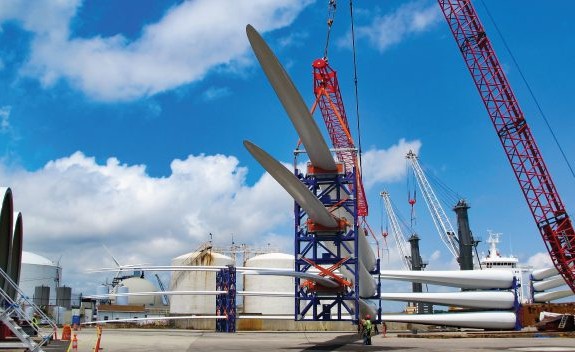Finally, the U.S. Is About to Get Its First Offshore Wind Power
As America’s first offshore wind farm gets ready to be switched on, hopes are high that, finally, the country may be ready to embrace waterborne wind turbines.
Despite years of false starts and slow progress that has seen Europe jump light years ahead of the U.S. in offshore wind, there is reason to be optimistic. As has often been said, the potential for developing offshore wind power in domestic waters is huge—around 4,200 gigawatts (a gigawatt is equivalent, very roughly, to the capacity of a large coal-fired power plant). The Block Island Wind Farm barely scratches the surface—just five 6-megawatt turbines, enough to provide power to nearby Block Island and send some juice to the mainland.
But it’s also an important toehold. The company behind the project, Deepwater Wind, has far greater ambitions, including a 90-megawatt offshore project meant to bring wind power to Long Island, and a further expansion of its wind farm in Rhode Island to include up to 1,000 megawatts of capacity spread over 200 turbines. Across the country, developers have drawn up plans for almost five gigawatts' worth of offshore turbines.

It’s not clear, however, that offshore wind is primed to compete with other forms of power. Installing huge turbines at sea is pricey—the Block Island project cost $300 million. It was made feasible by the power purchase agreement between Deepwater Wind and the utility company National Grid, which guarantees that Deepwater will get premium prices for power from the turbines for the next two decades. That only makes sense because of a second unique quirk: Block Island residents get their electricity from diesel generators, which are exorbitantly expensive to run. So the high prices Deepwater needs to make the project profitable still come in as a bargain.
Then there’s the issue of transmission. As part of the project, Deepwater has built a transmission cable to Block Island and another, longer one to mainland Rhode Island. But scaling up this project to include, say, a large chunk of the East Coast, is easier said than done.
In 2010, for example, Google said it would invest in a proposal to build an offshore wind “backbone” called the Atlantic Wind Connection. Expected to cost up to $5 billion to complete, it was meant to provide high-tech transmission lines that could shuttle offshore wind power to the mainland grid from New Jersey to Virginia. But as of last year, the project still hadn’t started and was in serious danger of never getting off the ground.
America’s offshore clean energy revolution, it would seem, could still use a bit more wind in its sails.
(Read more: New York Times, Electrek, “Is Offshore Wind Making Any Progress?” “Wind Fuels the North Sea’s Next Energy Boom”)
Keep Reading
Most Popular
Large language models can do jaw-dropping things. But nobody knows exactly why.
And that's a problem. Figuring it out is one of the biggest scientific puzzles of our time and a crucial step towards controlling more powerful future models.
The problem with plug-in hybrids? Their drivers.
Plug-in hybrids are often sold as a transition to EVs, but new data from Europe shows we’re still underestimating the emissions they produce.
Google DeepMind’s new generative model makes Super Mario–like games from scratch
Genie learns how to control games by watching hours and hours of video. It could help train next-gen robots too.
How scientists traced a mysterious covid case back to six toilets
When wastewater surveillance turns into a hunt for a single infected individual, the ethics get tricky.
Stay connected
Get the latest updates from
MIT Technology Review
Discover special offers, top stories, upcoming events, and more.